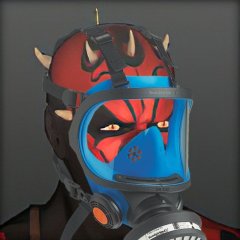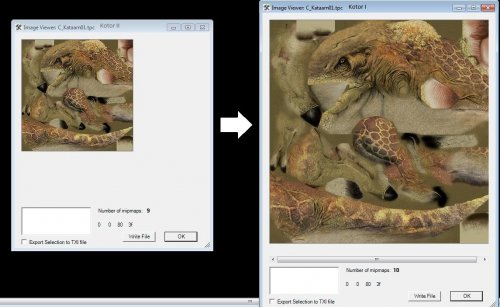-
Content Count
4,786 -
Joined
-
Last visited
-
Days Won
545
Content Type
Profiles
Forums
Blogs
Forum & Tracker Requests
Downloads
Gallery
Store
Calendar
Everything posted by DarthParametric
-

Porting "Lightsaber_Floating" from TSL to K1
DarthParametric replied to DarthVarkor's topic in Mod Requests
You need to create a new row for it in K1's appearance.2da, copying across the appropriate values from TSL (bearing in mind the differences in columns). I gather you have already done that part. Then you need to create a new UTC for it. You can do this by duplicating an existing K1 UTC, changing the appearance, giving it a unique resref/tag, giving it appropriate feats, editing the inventory, etc. Look at c_lightsaber004.utc in 907MAL to see what Obsidian did. After that, you'll need to add it to the module's GIT to make sure it spawns in the module. Depending on what you want it to do, you may also need additional scripts and/or dialogues. -

Porting "Lightsaber_Floating" from TSL to K1
DarthParametric replied to DarthVarkor's topic in Mod Requests
The floating lightsaber is just a rig with animations, essentially an invisible hand. Treat it like any other creature or NPC. It needs a UTC with a lightsaber equipped on its paperdoll. And of course you need to recompile the model for K1. -
There's also this one:
-
Another breath mask option: There's a lot of fixing required for some of these due to backface culling issues.
-
Well it appears to be a greyscale bumpmap - albeit an odd one - rather than a tangent space map, but it converts to RGBA with a transparency mask in the alpha. But neither the diffuse nor bump have any TXI data that I can see. It was pointed out to me by @Salk in this thread. I believe I did mention it to you in a PM at some point. LKA_leaf01.7z
-
Ah. I wasn't sure if the pics were before or after. But I guess I gave you a couple of fixes to add for the next update.
-
And what exactly are said fixes? From the pictures I imagine something like: Removing Manaan airlock transitions Not highlighting new items in inventory? Fixing UV seams on random pipes on Tatooine? Czerka office? Making the alien hating guy on Taris a human? ?? No idea Turret sides don't extend to the edge of the screen in widescreen
-
So you're saying it doesn't ever make use of an alpha mask for transparency, even though there's at least one vanilla normal map with an alpha mask? Although the map in question appears to be unused in the actual game, at least judging by the TXI semantics of its parent diffuse.
-
Looking at the version I have here (v13), the left hand and thumb and the right fingers have inverted UV faces. As do the left arm, chest, right leg, left boot upper, right boot lower. Although the left arm is intentional presumably, as it shares UVs with the right arm. Edit: The boots are also overlapping, I'm guessing probably the original UVs? That sort of weird half and half inversion is typical of vanilla UVs.
-
-
You have to decompile the scripts yourself. That snippet is from the decompiled on-enter for TAR_M03AE (Javyar's Cantina). You'll want DeNCS for that - http://www.starwarsknights.com/mtools/DeNCS.zip I would suggest creating a duplicate copy in a separate folder and using K1's nwscript.nss for decompiling K1 scripts.
-
You'll probably need to add to the module's on-enter script. Something like this: sub3(OBJECT_SELF); oAreaObject = GetFirstObjectInArea(OBJECT_INVALID, 64); while (GetIsObjectValid(oAreaObject)) { if ((GetTag(oAreaObject) == "ptar_pazplayer")) { AssignCommand(oAreaObject, ActionPlayAnimation(206, 1.0, 0.0)); } if ((GetTag(oAreaObject) == "ptar_sitter")) { AssignCommand(oAreaObject, ActionPlayAnimation(204, 1.0, 0.0)); } if ((GetTag(oAreaObject) == "ptar_drinker")) { AssignCommand(oAreaObject, ActionPlayAnimation(205, 1.0, 0.0)); } oAreaObject = GetNextObjectInArea(OBJECT_INVALID, 64); } Check the on-enter scripts of other modules with sitting placeables to see what they do. Edit: The 64 in the oAreaObject statement equates to OBJECT_TYPE_PLACEABLE. The 204/205/206 in the ActionPlayAnimation statements equate to ANIMATION_PLACEABLE_ANIMLOOP01/02/03, respectively. You'll want to check the model to see what animations it has to determine which you want to play. Edit 2: Ah, that's right, the placeable sitters are actually just standard character models. The animations are on the S_Male02 supermodel. Looking at it in Max, ANIMLOOP01 is a static sitting pose, ANIMLOOP02 is sitting and drinking, ANIMLOOP03 is sitting playing pazaak.
-
All your right arm UV faces are inverted, but the left arm shoulder faces are also inverted. This could be related to that, although I would have been more likely to suspect that in the case of overlapping UVs, which these aren't. As I said in the edit above, I wonder if a remap of the arms isn't worth trying.
-
The alpha should be solid white in your case. As far as I am aware, it is only a transparency mask (although I haven't actually gotten around to testing it with transparency). Your highlight issue would appear to be along the UV seam on the shoulder? And I gather it's the same with the wrists. Edit: How about remapping the arms something like this? Obviously ignore the scale/placement in the layout, I'm talking more about hiding the seams on the underside/back of the arm and eliminating the seam on the top of the arm altogether.
-
Apologies. Yes, you'll want to set the DXT5 flag in TGA2TPC. The DTX1 implementation is RGB only, hence why it crashes I would guess. I'm not sure why uncompressed would cause a crash. That would be a question for @ndix UR. Edit: Ah, you said RGB. That would likely be the problem. It needs to be RGBA. The DXT5 conversion is presumably adding an alpha if the source image lacks one. The simple trick to remember for direction is that if the detail is meant to be raised, that detail on the normal map should appear to be coming out of the screen (versus going into the screen in a DirectX/-Y map). It's often problematic when you are generating normal data from images, especially colour images. It's not uncommon to have some details being flipped in direction vs others in the same image, even when they should be pointing in the same direction, requiring manual flipping of those areas rather than the whole channel.
-
Yes that's outdated, erroneous information. That thread was continued here. For clarity, Odyssey requires OpenGL (i.e. +Y) tangent space normal maps with an alpha mask, formatted as a TPC. The reason the whole indexed colour thing came up in the first place was that the engine would not accept TGA (or DDS) RGBA bumpmaps, but it would accept greyscale TGA bumpmaps. People thought they could "cheat" in a normal map when it was discovered that it also accepted indexed colour TGAs, but it was proven that the game simply read it as a greyscale bumpmap, not a normal map. As I said above, ndix UR seems to have implemented an undocumented feature into TGA2TPC (or at least one I was unaware of) that converts an indexed colour image to RGB and normalizes it (i.e. generates Z data in the B channel). So that was why you got a functional map out of it. But it doesn't know what handedness the source image is. The nVidia filter is DirectX based, so it produces -Y normal maps. To switch these to OpenGL/+Y, all you need to do is invert the G channel (CTRL I in PS).
-
That's not how you make a normal map. A tangent space normal map is RGB (plus an alpha mask for Odyssey). If you want an actual bump map, that is greyscale. Additionally, your Y direction was wrong. See this post. It seems like ndix UR put some provision in TGA2TPC for dealing with indexed colour maps, judging by converting your original TPC back to TGA, but the Y was still inverted.
-
Your source normal map is incorrectly formatted. Try this and see what happens: Edit: Whoops, made a meal of the first one. 2nd attempt - Alt_JC_HandBA_B_v2.7z Also, for future reference you can dispense with the isdiffusebumpmap 1 isspecularbumpmap 1 TXI semantics. Per discussions with @ndix UR, they are leftover remnants from NWN that aren't actually used by Odyssey.
-
-
That's just more art. That doesn't advance the project, if anything it pushes it even further along the wrong path. Artists are a dime a dozen. A monkey could slap together some art assets in Unreal and call it a game (as evidenced by all the asset flips on Steam). What a game needs is programmers. If you don't have any then you shouldn't even bother starting a project. If I was going to undertake a hypothetical KOTOR remake (and let's call it what it actually is and dispense with this "mod" BS) in Unreal or other 3rd party engine, I would start with a fully functional recreation of the Endar Spire level. Forget about the art assets, simple white box mockups and default Unreal characters would suffice. What matters in an RPG is the underlying systems. If you are starting KOTOR from scratch, you need to develop a multi-node branching conversation system, equipment and inventory system, stats and levelling system, party/companion system, ranged and melee combat mechanics, etc. The Endar Spire is the perfect test level for developing and testing that. You have a couple of NPCs with a few lines of dialogue, a couple of conversations, a few combat encounters, a few cutscenes, etc. all in a very small space comprised of a few small rooms linked by corridors. And if you haven't demonstrated even a fraction of any of that after 2 or 3 years of screwing around, you should just stop wasting your time.
- 266 replies
-
- 12
-

-

-

-
Lol no. They are just a bunch of kids playing around in Unreal with emissive textures. They don't actually have any ability to make a game.
-
Got some more, although they aren't really supposed to be used with heads with hair (but meh). And if anyone wants to make suggestions for replacements, here's a chart of what the vanilla masks look like: Edit: And a couple more to round out the evening's work:
-
Arcann's mask cut in half and mirrored makes for a pretty good full face mask. Or if you prefer to get your temple guard on: Although there are some clipping issues with hair on certain heads, like Hispanic Mullet Man above. Might have to play with that a bit. Edit: And to replace the Tulak Hord helmet in K1 Generally full helmets don't work too well without being scaled up to ridiculous proportions, but this was already pretty giant to begin with, so it shouldn't be too bad for a decent percentage of player heads.
-
Sounds like user error. Since the removal of the porting ban, I have moved models between both games and had no issues. You need to describe your workflow in detail.
-
Some additional masks: I still need a few more, particularly for the full face masks, but I have enough to start trying to figure out what replaces what. I plan to edit UTIs to point to the new models, rather than just overwrite the vanilla models. That will allow for swapping things around a bit. Here's how the vanilla items are set up: I figure the Eradicator mask in the first post is an obvious choice for the Sith mask, but I'm open to suggestions for which other items should get which model.


